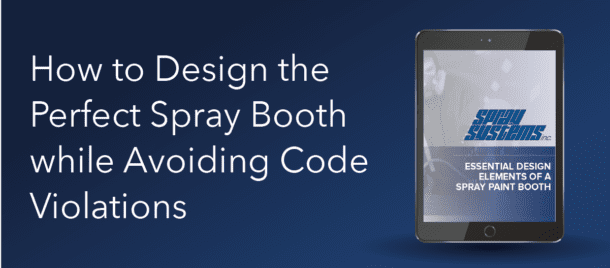Read Time: 3.5 minutes
Paint Booth Fire Safety Compliance Guide Summary:
- NFPA 33 is intended for fire control for large-scale, indoor spray paint applications such as industrial spray paint booths. Therefore, manufacturers who use a non-flammable coating are not required to abide by the standard.
- Sprinkler systems, as regulated by NFPA 13, are one common way to comply with this standard. If a fire is ignited, the automatic sprinklers will turn on to put out the flames. Other acceptable spray booth fire suppression measures are also outlined in the full version of the document, or you can see their key points here.
- Fire prevention measures are included in both the paint spray booth design and the process flow. There are booth ventilation requirements to reduce the buildup of flammable material.
- Although NFPA 33 addresses safety through fire regulation, the standard alone does not meet all the requirements for a safe paint booth environment. NFPA 33 is designed to specifically address fire safety. Additional codes are required to meet workers’ health and safety guidelines and environmental regulation.
- There are OSHA standards that protect booth operators from toxic properties found in paint chemicals and the NESHAP organization sets a minimum amount of what types of pollutants can be released into the atmosphere.
Manufacturers become subject to many regulations when deciding to install a paint spray booth in their production line. Because paint is both a toxic and flammable substance, there are regulations that control its uses so it can be applied in a safe, environmentally-responsible manner.
However, the regulations that apply depend on the manufacturer’s chosen spray system. In this article, we’ll explore the application of NFPA 33, a fire safety standard from the National Fire Protection Association. The following sections address:
- What paint spray processes are subject to NFPA 33?
- How are fire hazards controlled through NFPA 33?
- What are the limitations of NFPA 33?
What paint spray processes are subject to NFPA 33?
Although many spray paint booth applications are subject to NFPA 33, not all paint coating processes are covered by the standard. NFPA 33 is intended for fire control for large-scale, indoor spray paint applications such as industrial spray paint booths. Therefore, manufacturers who use a non-flammable coating are not required to abide by the standard.
Additionally, small-scale operations that use less than 1L over an 8-hour period would not be required to comply. Paint operations that take place outdoors are also exempted, as overspray buildup is unlikely to cause a fire hazard.
How are fire hazards controlled through NFPA 33?
NFPA 33 includes processes designed to reduce the risk of fire due to flammable paints and coatings. Sprinkler systems, as regulated by NFPA 13, are one common way to comply with this standard. If a fire is ignited, the automatic sprinklers will turn on to put out the flames. Other acceptable fire suppression measures are also outlined in the full version of the document, or you can see their key points here. This standard not only provides guidelines for suppressing ignited fires, but also for preventing the fire in the first place.
Fire prevention measures are included in both the paint spray booth design and the process flow. There are booth ventilation requirements to reduce the buildup of flammable material. An adequate amount of ventilation air is needed to avoid saturating the air with enough flammable material to make ignition possible.
Flammable material overspray buildup is also a concern because it can be considered another possible source of fuel for fire ignition. NFPA 33 addresses overspray buildup issues with thorough cleaning requirements and also addresses how to properly dispose of flammable waste after cleaning is completed. To further prevent the risk of fire, the standard also provides guidelines for limiting sources of ignition in the paint spray—ranging from open flames to even hot lamps.
While the standard does provide guidelines for suppressing an ignited fire, the true goal is to prevent fires by limiting sources of ignition, reducing overspray buildup and properly disposing of flammable waste.
What are the limitations of NFPA 33?
Although NFPA 33 addresses safety through fire regulation, the standard alone does not meet all the requirements for a safe paint booth environment. NFPA 33 is designed to specifically address fire safety, so additional controls are required to meet workers’ health and safety guidelines as well as environmental regulation.
Aside from the NFPA 33, there are also health and safety regulations set by OSHA. Because the chemicals used in most spray and finish applications are flammable and also have toxic properties, they are a serious risk to human health and the local environment, so there are procedures to ensure that these chemicals do not harm the environment and the people working with them. Failure to comply by set regulations on a state and local level can get your business fined or penalized.
NESHAP, the National Emission Standards for Hazardous Air Pollutants, establishes specific sustainability goals and sets a minimum amount of what types of pollutants can be released into the atmosphere. Any booth operator spraying an aircraft primer that contains hexavalent chrome are subject to abide by NESHAP and paint booth requirements. When installing a spray booth of any kind, it’s important to speak with a NESHAP or Environmental Protection Agency agent to verify you are abiding by state and national standards.
NFPA 33 is an important safety document, but it is only one component of a much bigger picture. Other standards must also be met before the paint spray booth can be used safely and effectively. Trust your spray paint booth design in the hands of the experts that will ensure a compliant, quality booth—every time. Contact the team at (800) 736-6944 or complete the request a quote form here.
To view the code in its entirety, a full version is available on the NFPA website, or you can see the NFPA powerpoint summary here.




